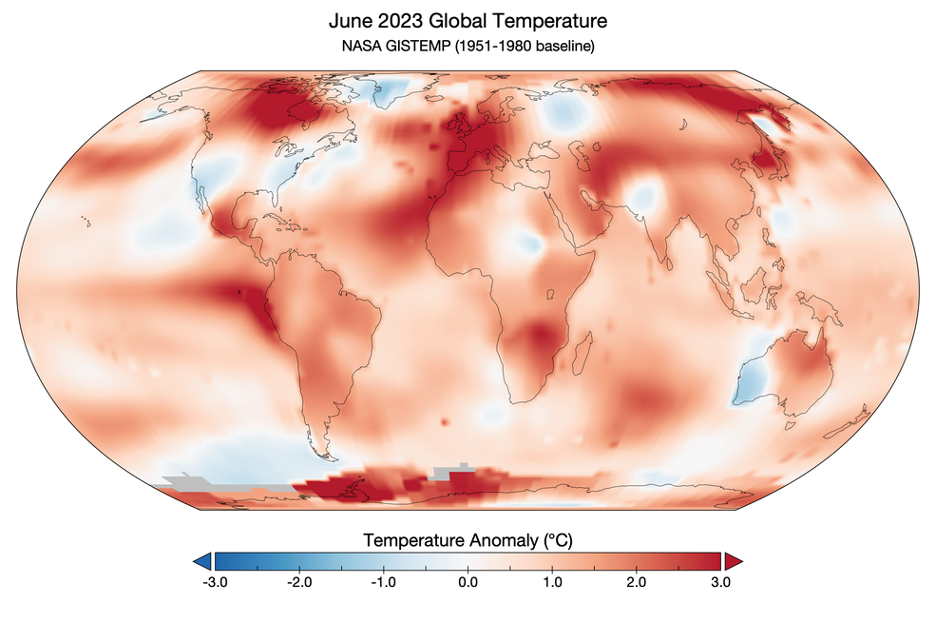The warming trend continues, with Earth’s average surface temperature in 2022 tied with 2015 – as the 5th warmest on record…
BI research staff, working in collaboration with NASA, estimate that the past nine years have been the warmest years since record-keeping began in 1880.
The warming trend continued with Earth’s average surface temperature in 2022 tied with 2015 as the fifth warmest on record. And the latest analysis finds June 2023 was the hottest June ever recorded. In response to public interest in the analysis, BI research staff replaced static plots of with interative displays…
Background: Earth’s Global Temperature Record
Accurate estimates of the Earth’s changing global surface air temperatures – a primary measure of global climate change – are critical for comparison with estimates produced from climate models designed to simulate the effects of changes in atmospheric carbon dioxide, aerosols, and solar irradiance.
In the early 1970s, researchers at NASA’s Goddard Institute for Space Studies (GISS) set out to provide estimates of the Earth’s changing global surface air temperatures. On-going Goddard Institute Surface Temperature (GISTEMP) analysis updates global temperature change from the late 1800s to the present and highlights an alarming warming trend, with the past nine consecutive years being the warmest nine since recordkeeping began in 1880. BI and NASA researchers estimated 2022 as one of the warmest years on record (tying 2015 for 5th), despite a third consecutive year of La Niña conditions in the tropical Pacific Ocean, which act to cool global temperatures. The Artic continues to experience the strongest warming trends at close to four times the global average, with the latest analysis finding June 2023 to be the hottest June ever recorded.
The consequences of the warming, attributed to human-driven greenhouse gas emissions, are already being seen with the loss of sea ice, melting glaciers, sea level rise, intensification of forest fires, and strengthening hurricanes.


Strategy: Using Cutting-edge Tools to Analyze, Tabulate and Plot Data for Public Use
Recognizing the importance of accurate global surface air temperatures, BI staff collaborate with NASA research scientists at NASA’s Goddard Institute for Space Studies (GISS) to continue and advance the GISTEMP analysis. A key objective is to make these data accessible to scientists, policy makers, and the public in a format that is easily digestible. To that end, NOAA GHCN v4 and SCAR surface air temperature and ERSST v5 Sea Surface Temperature (SST) data files are analyzed, tabulated, and plotted monthly. The analysis includes surface temperature measurements from more than 26,000 weather stations and thousands of ship- and buoy-based observations of sea surface temperatures. The analysis is presented on the public GISTEMP v4 website.
When the GISTEMP website was created, its main purpose was to use web utilities to analyze the historical record, to determine whether events like volcanic eruptions could be successfully reproduced by the GISS model.
However, as global temperatures rose, the general public became interested in that web site, mainly to speculate about what the future might look like. Later, increased politicization of the science of climate change resulted in attacks of our results and methods, including an avalanche of Freedom of Information Act requests, hostile emails, and a lawsuit. This was overcome by the publication of all the programs that were used, including extensive documentation. A history section was also added to explain the development of the analysis and tp illustrate the effect of the various changes on the results.
Due to the public interest, the static graphics were replaced by interactive displays.
More emphasis was also placed on exhibiting and estimating the degree of accuracy of the results. With the help of an expert in statistics, a thorough investigation was conducted of the uncertainty of our estimates created by the temporal and spatial gaps in the temperature records and the methods used to overcome those problems.
Lessons Learned / Next Steps
The major technical challenge was to find a method to overcome the unequal distribution in space and time of the available temperature reports in order to achieve reasonably accurate global means and to estimate their accuracy. Handling this involved preliminary studies of the correlation of temperature time series as a function of the distance between the locations as well as subsampling techniques.
A problem of a different kind was how to handle inquiries, criticisms, and hostile attacks. All technical questions and criticisms are taken seriously and dealt with quickly and in a professional way. An FAQ section was created to use as reference for recurring questions or criticisms.
Follow-up activities involve making the websites as accessible as possible on all media from hyperwalls to cell phones as well as to people with disabilities, e.g., color blindness. Another next step is to speed up the analysis process by either using new features of Python or reviving the old version written in FORTRAN, at least for the core computations that convert station data into a gridded data set of temperature anomalies.
Acknowledgements
The GISTEMP project is supported by BI research staff and led by research scientists at NASA’s Goddard Institute for Space Studies. GISS is a NASA laboratory in the Earth Sciences Division (ESD) of the Agency’s Goddard Space Flight Center (GSFC). The ESD is part of GSFC’s Sciences and Exploration Directorate. The GISS laboratory is affiliated with the Columbia University Climate School and the School of Engineering and Applied Sciences in New York.

Author
John Barbara
NASA Project Manager
About the Author
John Barbara is a manager of research and operations, contracted through Autonomic Integra (AI) – a joint-venture small business between BI and Autonomic Enterprise – at NASA’s Goddard Institute for Space Studies. His team provides scientific programming and analysis support in four categories: global climate modeling, earth observations, climate impacts, and planetary/exoplanetary climatology. John’s research is focussed on planetary atmospheric dynamics, and he is the author of several scientific publications.
About BI
Business Integra is an award-winning, global provider of information technology, cybersecurity, aeronautic engineering, scientific and mission support services. We are committed to producing efficient and ethical results that cut costs, reduce risks, secure data, and advance human progress via cybersecurity, IT, engineering and mission support services.
Follow us on Twitter @BusinessIntegr4 and/or LinkedIn.
BI awarded NASA’s ‘Small Business Prime Contractor of the Year’
HOME | NEWSAUGUST 30, 2020 | PRESS RELEASEBethesda, MD – In May 2021, Business Integra was honored to become an awardee of NASA Goddard Space Flight Center’s Small Business Prime Contractor of the Year for 2022! This award is given to companies that have met and...


